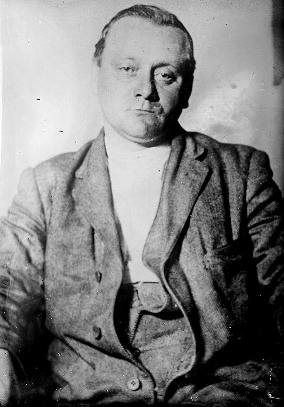
Insanity as a defense whether “temporary” or “permanent due to chronic mental illness” is never palatable to crime victims. On the one hand, we know intellectually that mental illness is a result of chemical or structural abnormalities in the brain and therefore, is “not their fault.” On the other hand, on an emotional level, mental illness is often viewed by crime victims as “an excuse for inexcusable criminal behavior.”
There are reams and reams of history going back to the 1800s , including the pioneering social welfare work of Dorothea Dix, supplanting squalid care of the mentally ill with the preferred “asylum care” of her era. However, such is not the focus of this blog.
Ladyjustice would rather focus on some interesting, baffling and bewildering insanity cases of yesteryear…and a law or two as a consequence of insanity.
However, in case the following examples aren’t palatable, consider listening to this classic YouTube video by Paul Simon as a precursor….and listen to it again as a “chaser” to the “bitter pill of insanity.”
Link: http://www.youtube.com/watch?v=46bkXgxb66E
1) Insane- Really!
Richard Lawrence (Acquitted, 1835)
 Richard Lawrence was an unemployed house painter in his 30s who fired two pistols at U.S. President Andrew Jackson as Jackson walked through the Capitol Rotunda during a funeral procession. Both pistols misfired, and Lawrence was quickly apprehended. He was the first person charged with the attempted assassination of a U.S. president.
Richard Lawrence was an unemployed house painter in his 30s who fired two pistols at U.S. President Andrew Jackson as Jackson walked through the Capitol Rotunda during a funeral procession. Both pistols misfired, and Lawrence was quickly apprehended. He was the first person charged with the attempted assassination of a U.S. president.
Lawrence apparently suffered from delusions of persecution, believing that he was heir to the British throne and believed that Jackson conspired to keep him from receiving a fortune with which he could return to England and claim his seat. He also believed that Jackson had killed his father.
At his one-day trial, Lawrence repeatedly interrupted the proceedings, loudly proclaiming that he was “the King of England and Rome.” The jury acquitted him by reason of insanity after only five minutes of deliberation. Richard Lawrence spent the rest of his life (26 years)… in an asylum.
2) Insanely Jealous!
Daniel Sickles (Acquitted, 1859)
 In 1859, U.S. Congressman Daniel Sickles was charged with murder after he shot and killed U.S. District Attorney Phillip Barton Key in broad daylight, within full view of the White House.
In 1859, U.S. Congressman Daniel Sickles was charged with murder after he shot and killed U.S. District Attorney Phillip Barton Key in broad daylight, within full view of the White House.
Philip Key was the son of Francis Scott Key, the author of The Star Spangled Banner. Philip had an ongoing notorious and conspicuous affair with Sickle’s wife.
During Sickle’s sensational and highly publicized trial, his attorney argued that “he committed the murder in a state of temporary insanity, brought on by the enraging knowledge that Key was sleeping with his wife.”
The all-male jury accepted this argument, subsequently acquitting Sickles.
He later served as a major-general in the Civil War, and received a Congressional Medal of Honor for his service having lost his leg at the Battle of Gettysburg.
[Ladyjustice: We “forgive and forget” as long as we serve admirably in battle??]
3) Presidential Insanity
John Schrank (Institutionalized for Life, 1912)
 New York bartender, John Schrank shot President Teddy Roosevelt at close range while the former president was campaigning for a second term in Milwaukee, Wisconsin. As luck would have it, the bullet hit Roosevelt in the chest, piercing a metal eyeglasses case and a 50-page copy of the campaign speech he was carrying in his suit pocket.
New York bartender, John Schrank shot President Teddy Roosevelt at close range while the former president was campaigning for a second term in Milwaukee, Wisconsin. As luck would have it, the bullet hit Roosevelt in the chest, piercing a metal eyeglasses case and a 50-page copy of the campaign speech he was carrying in his suit pocket.
Defying his doctor’s orders, Roosevelt insisted on delivering the speech as scheduled before going to the hospital! Further evaluation revealed that the bullet had lodged at a depth of three inches inside the wall of his chest, but without damage to vital organs. When President Roosevelt died several years later the infamous bullet remained in his chest!
John Schrank, wannabe assassin, was immediately arrested. At the time of the shooting, he offered no reason for the attempted assassination. However, later accounts reported that he apparently suffered from delusions, saying that “William McKinley had appeared to him in a dream and told him to kill Roosevelt.”
Doctors determined Schrank was insane, after which a judge sentenced him to life in an asylum for the insane.
4) Insane…and in love with Jodie Foster!
John Hinckley (Acquitted, 1982)
 In 1981, John Hinckley Jr. shot U.S. President Ronald Reagan, a secret service agent, a Washington police officer, and Reagan’s press secretary, James Brady. Hinckley claimed that he was trying to impress the actress Jodie Foster, with whom he was infatuated. In what was arguably the most influential insanity-defense case of the century, a jury acquitted him of 13 assault, murder, and weapons counts, finding him not guilty by reason of insanity. He was committed to St. Elizabeth’s Hospital for the criminally insane in Washington, D.C., where he remains today.
In 1981, John Hinckley Jr. shot U.S. President Ronald Reagan, a secret service agent, a Washington police officer, and Reagan’s press secretary, James Brady. Hinckley claimed that he was trying to impress the actress Jodie Foster, with whom he was infatuated. In what was arguably the most influential insanity-defense case of the century, a jury acquitted him of 13 assault, murder, and weapons counts, finding him not guilty by reason of insanity. He was committed to St. Elizabeth’s Hospital for the criminally insane in Washington, D.C., where he remains today.
After the Hinckley verdict, there was an immediate public outcry against what many perceived to be a loophole in the justice system allowing an obviously guilty man to escape punishment. There were widespread calls for the abolishment, or substantial revision of the legal criteria for insanity.
Reportedly, more than 30 states changed their laws as a consequence of this historic event to make it more difficult for defendants to succeed in substantiating an insanity defense. Congress responded by passing the Insanity Defense Reform Act, which tightened federal standards.
[Ladyjustice- See related information below]
Insanity Defense Reform Act of 1984
The Insanity Defense Reform Act of 1984, signed into law on October 12, 1984, was the first comprehensive Federal legislation governing the insanity defense and the disposition of individuals suffering from a mental disease or defect who are involved in the criminal justice system. The more significant provisions were that the legislation accomplished the following:
- 1. Significantly modified the standard for insanity previously applied in the Federal courts;
- 2. Placed the burden of proof on the defendant to establish the defense by clear and convincing evidence;
- 3. Limited the scope of expert testimony on ultimate legal issues;
- 4. Eliminated the defense of diminished capacity;
- 5. Created a special verdict of “not guilty only by reason of insanity,” which triggers a commitment proceeding; and
- 6. Provided for Federal commitment of persons should they become insane after having been found guilty at trial…or deemed insane while serving a Federal prison sentence.
[Cited in Criminal Resource Manual 61; USAM 9-18.000]
5) Insane Cannibal!
Jeffrey Dahmer (Convicted, 1992)
In 1991, Jeffrey Dahmer was convicted of the murder of 15 young men, whose mutilated, cannibalized bodies were found in his Milwaukee apartment. Dahmer reportedly had sex with the corpses. He also attempted to perform crude lobotomies on others while they were still alive. As part of his sick rituals, Dahmer stored body parts in his refrigerator to be eaten later.
During his trial, he admitted to the 15 killings. However, his plea was not guilty by reason of insanity. This plea was rejected. The jury subsequently found Dahmer to be legally sane at the time of the murders. He was sentenced to 15 consecutive life sentences without chance of parole!
The Dahmer conviction was reputed to be “the death of the insanity defense”, similar to the Hinckley acquittal. The public and the legal community felt that if such a clearly deranged killer could not be found legally insane, it seemed highly unlikely that the defense of guilty by reason of insanity would ever be successful in a high profile case involving a violent crime.
Post script:
Dahmer was killed in prison by another inmate in 1994.
[Ladyjustice: Prison justice!]
6) Insane and Pushed Under a Subway Train!
Andrew Goldstein (Convicted, 2000)
Andrew Goldstein was a diagnosed schizophrenic who had been released from psychiatric hospital just weeks before he killed 32-year-old Kendra Webdale.
Kendra was murdered as a result of Goldstein pushing her in front of a New York subway train in January 1999. Goldstein had a history of delusions was diagnosed as schizophrenic in 1989, following an incident in which he forcibly pushed his mother
In December 1992, Goldstein had committed himself to a state psychiatric hospital in New York. Although he displayed extremely delusional and violent behavior while in the hospital, he was transferred to a group home after eight months.
By 1996, he was living on his own in New York. Over the next three years, he would frequently went to emergency rooms, acting delusional and asking for help.
In November 1999, Goldstein again committed himself, this time to a hospital in Harlem. He told intake personnel that he wanted to be hospitalized because of “severe schizophrenia.” Hospital records from his stay describe him as “thought-disordered,” “delusional,” and “psychotic.” However, after less than a month, and just days after hospital records noted that he “remained delusional,” Goldstein was released from the hospital with a referral for out-patient therapy. Three weeks later, he pushed Kendra Webdale under the train!
[Ladyjustice: The system failed miserably and is in part responsible for Kendra’s murder!]
Goldstein’s first trial ended in a mistrial after the jury was deadlocked. A second jury rejected Goldstein’s insanity defense plea and convicted him of second-degree murder, just 90 minutes after beginning deliberation. He was sentenced to 25 years to life in prison.
In response to the Goldstein case, the New York legislature enacted and “outpatient commitment” statute — known as
“Kendra’s Law” — which authorizes courts to force mentally ill people living in the community to take medication. Kendra’s Law permitted for court orders to be obtained for non- medication compliant individuals to receive and accept outpatient treatment for their mental illnesses. The Law also authorizes the petitioning of designated individuals in the court system, on behalf of the mentally ill client, for Assisted Outpatient Treatment or to be temporarily hospitalized for up to 72 hours.
The Law is aimed specifically toward those persons who are: 1) 18 years or older,
2) Have a history of non-compliance with mental health treatment leading to two or more hospitalizations or periods in a forensic or mental health unit of a prison within 36 months prior to the filing of a petition,
3) Have committed one or more acts of serious violence toward self or others within the past 48 months,
4) Such persons are unlikely to participate voluntarily in recommended psychiatric treatment, and
5) Such persons are likely to suffer relapse that can result in serious physical harm to oneself or others without treatment (Mental Health Association in NY State, Inc., 1999).
The Law would allow family, roommates, qualified psychiatrists, directors of psychiatric hospitals, and local mental health officials to petition the courts for treatment for mentally ill men and women who may not function safely in the community without supervision.
In this way, both the public and the mentally ill are offered new and higher levels of personal safety. The services that would be targeted by the courts are case management, individual and group therapy, supervised living situations, alcohol and substance abuse counseling, testing for the presence of drugs or alcohol, and educational and vocational services (http://www.state.ny.us/governor/press/year99/may1999/ ). The array of outpatient services encouraged by this Law, if used correctly, will expand the capabilities of the state’s mental health system.
Promising Results… But the Fight Continues for Permanency (May 2010 & April 2012
Op-Ed Contributor
Make Kendra’s Law Permanent
By E. FULLER TORREY
Published: May 31, 2010
ELEVEN years ago, when the New York Legislature passed Kendra’s Law, few could have foretold what a resounding success it would be. At the time lawmakers were searching for a useful response to the tragic death of 32-year-old Kendra Webdale, who was pushed in front of a subway train in Manhattan by a stranger who had untreated schizophrenia.
The law, initially intended for a trial period of five years, permits state judges to order closely monitored outpatient treatment for a small subset of seriously mentally ill people who have records of failing to take medication, and who have consequently been rehospitalized or jailed or have exhibited violent behavior.
In 2005, Kendra’s Law was extended for another five years. In all, more than 8,000 people have been treated under its provisions, and the results have been striking.
A 2005 study of more than 2,700 people to whom the law was applied found that, after treatment, the rate of homelessness in the population fell by 74 percent, the number who needed to be rehospitalized dropped by 77 percent and the number arrested fell by 83 percent. And a study published this year found that people receiving treatment under Kendra’s Law were only one-fourth as likely to commit violent acts, had a reduced risk of suicide and were functioning better socially than members of a control group.
It’s hard to imagine a stronger argument for making the law permanent. And yet, as it comes up for renewal this month, the state Office of Mental Health is recommending only a five-year extension. Why the hesitation? Apparently, the Office of Mental Health is ambivalent about its star performer. In its latest five-year Statewide Comprehensive Plan for Mental Health Services, Kendra’s Law is not even mentioned, and the program it supports — assisted outpatient treatment — is referred to briefly only twice.
Perhaps state mental health officials are responding to critics who consider the law politically incorrect because it mandates psychiatric treatment by court order, supposedly violating the patients’ freedom to choose or forgo treatment. But these are people whose illness interferes with their ability to understand that they are sick and need medication. They do not have the choice to live freely and comfortably, but only to be homeless, in jail or in a psychiatric hospital.
The people who could be treated under Kendra’s Law account for only one in 10 seriously ill psychiatric patients. But when these people are untreated, they also make up one-third of the homeless population, and at least 16 percent of the jail and prison population. These people are ubiquitous in city parks, public libraries and train stations. And a small percentage becomes dangerous, even homicidal.
The law has been a model of success, not only in New York but also in 44 other states that now have similar laws (including, most recently, New Jersey and Maine). Unfortunately, these laws are too rarely used. California, for example, has passed an equivalent to Kendra’s Law known as Laura’s Law, but has not enforced it. If it had, it might have prevented 36-year-old John Patrick Bedell from wandering the country last March, taking orders from his psychotic brain, despite his family’s frantic attempts to get treatment for him. Mr. Bedell ultimately shot two security guards at the Pentagon, and was shot and killed by the officers he injured.
Kendra’s Law saves lives. By keeping patients on medication, it also saves money that might otherwise be spent on rehospitalization, prosecution and incarceration. New York should take lasting advantage of both benefits by making the law permanent.
[E. Fuller Torrey, the founder of the Treatment Advocacy Center, is the author of “The Insanity Offense: How America’s Failure to Treat the Seriously Mentally Ill Endangers Its Citizens.”]
Update April 2012
Albany — The mother of Kendra Webdale has a message for Brooklyn Assemblyman Felix Ortiz and other state lawmakers — stop waffling and strengthen Kendra’s Law.
Patricia Webdale, 70, said too many non-medicated mentally ill people remain on the streets, and it’s time to close the loopholes in the landmark 1999 mental health law named for her daughter.
“People are still falling through the cracks,” she told the Daily News.
Kendra’s Law allows the courts to forcibly administer treatments to dangerously disturbed individuals.
Patricia Webdale, who lives in upstate Fredonia, said the near-fatal stabbing of city Police Officer Eder Loor by schizophrenic ex-con Terrence Hale shows why the law needs to be strengthened.
Hale had stopped taking his medications after his release from prison.
The law was adopted by state lawmakers after Kendra Webdale, a struggling New York City screenwriter, was pushed to her death in front of a subway car in 1999 by a schizophrenic named Andrew Goldstein.
Since the law’s passage, Patricia Webdale has continually lobbied the Legislature to make it permanent — it must be renewed every five years — and to close what critics say are glaring loopholes.
Sen. Catharine Young (R-Cattaraugus County) and Assemblywoman Aileen Gunther (D-Sullivan County) have proposed a bill to strengthen the law.
It would force officials to review expiring treatment orders to see if they need to be renewed, and require the state prison system to notify local officials when mentally ill inmates are released.
Webdale blamed Ortiz, chairman of the Assembly’s Mental Health Committee, for bowing to pressure from advocates for the mentally ill and blocking the Young/Gunther bill.
“I have gone head to head with Ortiz and his office, and at times he has seemed extremely, genuinely supportive,” Webdale said.
“And then the tune would change.”
Ortiz said there has never been a consensus among lawmakers to support strengthening the law.
Following the stabbing of Loor, it will be reviewed.
“I will bring all the parties together and then we will take it from there,” Ortiz said.”
———————————————————————————————————————
Ladyjustice: ‘Like I said… Listen to Paul Simon on YouTube… At least he’s palatable DRG
 Donna Gore is a champion of victims rights and justice. She is a survivor of homicide and has turned her personal situations into a positive approach to life by participating in several areas of victim services. “LadyJustice” is the host of Shattered Lives on the Inside Lenz Network, Saturdays at 5pm ET.
Donna Gore is a champion of victims rights and justice. She is a survivor of homicide and has turned her personal situations into a positive approach to life by participating in several areas of victim services. “LadyJustice” is the host of Shattered Lives on the Inside Lenz Network, Saturdays at 5pm ET.











“The best beloved of all things in my sight is justice. Through it thou shalt see through thy own eyes, and not through the eyes of others.” — Baha’u’llah
I love Susan Murphy Milano, and not just because she has more hair than the entire rock band Vixen! You are certainly a force to be reckoned with, and it is, despite the best efforts at guarding the gates of ignorance by many, those of us who devote our energies to preventing homicides, dispelling the darkness of societal myths, and doing our best to make sure that cases are not just “cleared” (convict someone/anyone) but properly investigated and, if someone is charged, that thedefendant gets the best possible defense. After all, it is estimated that up to 40% of people in America’s prisons actually committed the crime! :-)-
With all sensitivity to the pain and trauma of losing a loved one to homicide, the term “homicide survivor” perpetrates a mutilation of language I find terribly disquieting. Equally peculiar is the alternative term, “Murder Survivor.” Calling people who remain alive after the passing of a loved one as “Death Survivors” is also bizarre, and conjures up images best realized by George A. Romero. As long as I am being a cranky old man, the other phrase that irks me is “Justice for (victim)” It is not the victim who requires justice, but the person accused of the crime. Based on my experience, people who cry for “justice for (victim)” a really calling our for retribution or vengeance, neither of which are aspects of justice.
Of course we could get into the hot topic of why Victim Impact Statements have no place in the courtroom, but that’s another issue entirely. Did you happen to hear our show about Willis Wilson, charged in the kidnapping and sexual assault of an innocent young woman? Police also linked him to a series of brutal child murders. The prosecutor attempted to get him to plead out and get only thirty years. He refused. Good thing he did. He was exonerated of all charges, and for good reason. They had the wrong guy. The victim still believes it was he because she picked him out of a line-up…easy to do , because he was the only man in the lineup who looked anything like her description of the perp! If you are interested, here is the link to the show :
http://adoraburl.typepad.com/williswilson2.mp3
Burl: Regardless of your age… you too make some intriguing points. Semantics and whether we should say “Homicide Survivor” and the like… We all have our preferences and could debate it until the cows come home. Although language is important, it is not as important as actions and the passion in one’s heart for the greater good for “something worthwhile.” It’s a good thing there are advocates like you who fight for the rights of the innocently convicted. There is a true place for all of us in this world…as long as we use it for positive change!
Respectfully,
Donna “Ladyjustice”
Burl! Thank you so much for your comments! I am honored… and if you know your way around Imagine Publicity, I am often a force to be reckoned with and write extensively as well! I heard your comment re brain damage when you were on SMM’s show! As a former clinical speech- language pathologist,and homicide survivor, I find it interesting…. Hope you’ll check out my website too! Stay in touch!
Thanks!
Donna “Ladyjustice”
Thank you for this excellent feature. This is a most important topic, and one that I devote much attention to (too much, according to some) in my book, FATAL BEAUTY. Essentially we are conducting a criminal justice system based on 19th Century suppositions which are increasingly at odds with scientific evidence regarding the reality of brain damage suffered by over 50% of those facing criminal charges — and most of those being the result of FASD.